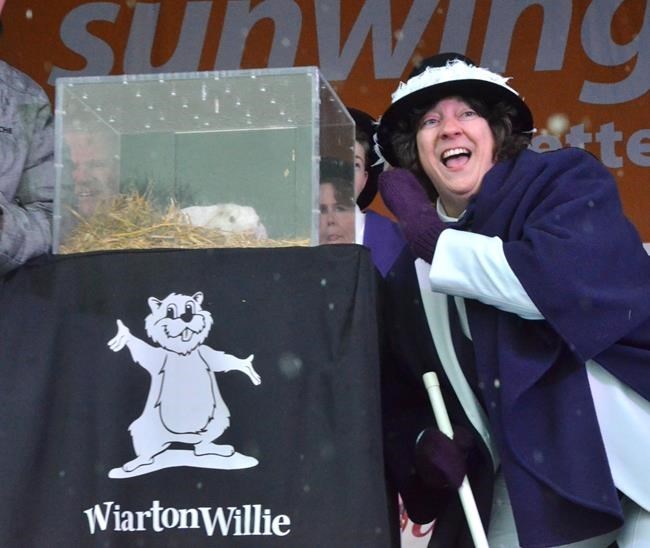Canada's best-known weather-predicting groundhogs called for an early spring Tuesday as they delivered their annual forecasts over video due to the COVID-19 pandemic, though one was missing in action.
Nova Scotia's most famous groundhog, Shubenacadie Sam, was the first to make his prediction, hesitantly emerging from his pint-sized barn and apparently failing to see his shadow.
At exactly 8 a.m. local time, the door to Sam's enclosure was opened, but the pudgy rodent refused to come out at first.
With a winter storm descending on the Maritimes overnight, there was a steady snowfall as Sam emerged from his den and waddled a few paces from the front door.
The annual tradition at the Shubenacadie Wildlife Park north of Halifax usually attracts scores of schoolchildren, but not this year. There were few onlookers Tuesday as the event was broadcast live on Facebook to comply with COVID-19 health protocols.
As usual, Shubenacadie Sam was the first groundhog in North America to make a prediction.
In Val d'Espoir on Quebec's Gaspe peninsula, Fred La Marmotte was also reluctant to leave his miniature cabin.
When the rodent did finally emerge during the livestreamed event, his handler held him to his ear and said he had predicted an early spring.
In Wiarton, Ont., the community's famous albino groundhog, Wiarton Willie, was nowhere to be seen as officials called an early spring after throwing a fur hat into the air -- a move they said hearkens back to the tradition's first edition more than 60 years ago.
"The committee decided to pay tribute to the first prediction (which did not include a groundhog, only a fur hat) because it was the 65th anniversary this year and we were not able to host a live event due to COVID," the town's deputy clerk said in an email.
The spring forecast was delivered by Janice Jackson, the mayor of the Town of South Bruce Peninsula, in a pre-recorded video that also included a brief history of the event.
Meanwhile, those south of the border were told to expect six more weeks of winter as Pennsylvania's Punxsutawney Phil emerged from his burrow.
The critter performed his Groundhog Day duties over livestream, with more than 15,000 viewers tuning in at one point. No spectators were allowed in person due to the pandemic, but cardboard cutouts were included to mimic their presence.
A member of Phil's "inner circle" noted the uniqueness of the past year.
“People have been referencing Groundhog Day. It has felt like at times we're all living the same day over and over again,” one of the members said. “Groundhog Day also shows us that the monotony ends. The cycle will be broken.”
According to folklore, if a groundhog doesn't see his shadow on Groundhog Day, spring-like weather will soon arrive. However, if the pug-nosed critter spots his shadow, winter will drag on.
Folklorists say the Groundhog Day ritual may have something to do with Feb. 2 landing midway between winter solstice and spring equinox, but no one knows for sure.
In medieval Europe, farmers believed that if hedgehogs emerged from their burrows to catch insects, that was a sure sign of an early spring.
However, when Europeans settled in eastern North America, the groundhog was substituted for the hedgehog.
-with files from The Associated Press
This report by The Canadian Press was first published Feb. 2, 2021.
The Canadian Press

